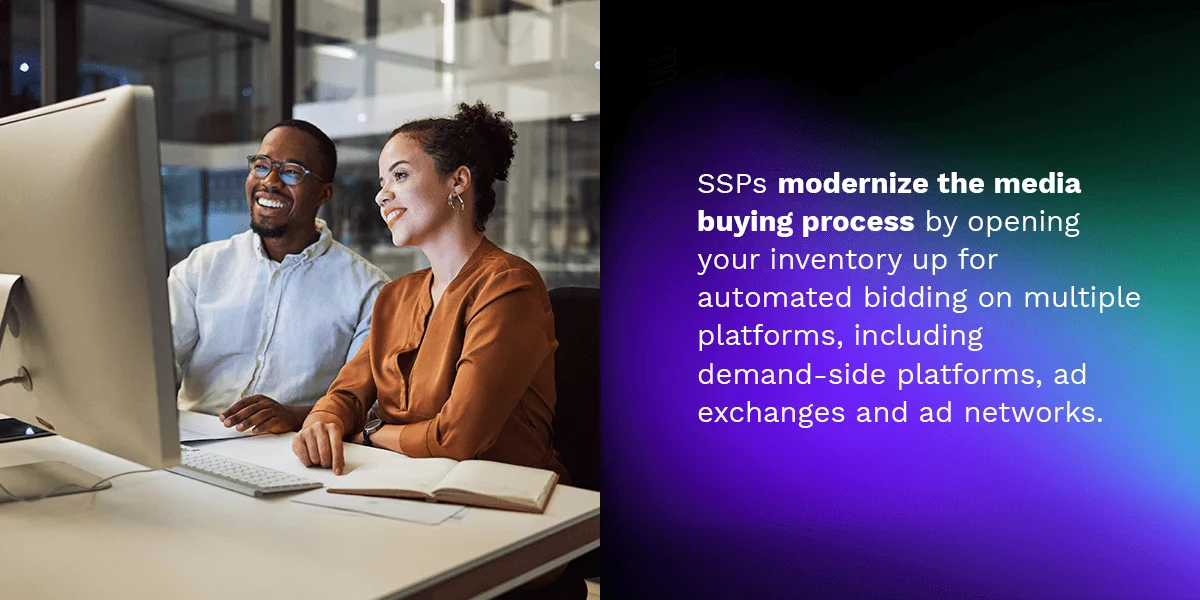Since the mid-2000s, supply-side platforms have been an integral element in programmatic advertising. They’ve enabled publishers to sell inventory at scale, ensuring all available ad spaces were filled while maximizing the revenue these impressions generated. Publishers now have the ability to determine who they will sell impressions to as well as maximize the prices of those impressions.
Understanding how supply-side platforms work can help you determine whether investing in one is a good idea for your organization.
What is a supply-side platform (SSP)?
A supply-side platform, also known as a sell-side platform or a yield optimization platform, is a software platform ad publishers use to sell their digital inventory.
Essentially, it is the publisher’s interface for ad networks and exchanges, which interface with demand-side platforms (DSPs) on the advertiser side.
All SSPs have the following five components:
- Infrastructure: Your IT infrastructure is what hosts the backend of your SSP and powers its features. Without the proper infrastructure, your SSP would be unable to perform.
- SSP integrations: Integration with other AdTech platforms, such as DSPs, ad servers and data management platforms, facilitates inventory sales and helps to optimize yield.
- Ad exchange access: Some SSPs have built-in ad exchange functionalities that provide direct access to advertisers via DSPs, which means you can sell impressions without having to go through an external exchange.
- Trackers: An SSP’s tracking system collects data about your website and audience, then sends it to the internal database for analysis and reporting.
- Reporting database: This database receives information about campaigns and audiences from the tracker, enabling publishers to generate reports and view performance analytics.
Each different SSP may also provide proprietary features that can supplement your existing advertising strategy. Before choosing a platform, publishers should carefully weigh out their options to find one that works best for them.
Why are supply-side platforms important?
In the past, an ad publisher manually assigned specific ads to spaces through negotiations with human media buyers and sales teams. While this manual approach worked then, the rise of the internet and the steadily growing competition among digital marketers have made it obsolete.
SSPs modernize the media buying process by opening your inventory up for automated bidding on multiple platforms, including demand-side platforms, ad exchanges and ad networks.

This makes an SSP a key part of the real-time bidding (RTB) process in programmatic advertising. It handles the following processes:
- Ad network optimization: SSPs enable advertisers to purchase individual impressions, increasing publishers’ control over their inventory. Through data collection and analysis, publishers can see who is buying impressions and optimize ad requests to match.
- RTB transactions: Using automated algorithms and ad exchanges, SSPs sell ad impressions to advertisers through DSPs.
- Advertiser filtering: The publisher can apply filters, such as white and blacklists, to make sure only relevant advertisers can bid on their inventory.
- Frequency capping: SSPs and DSPs work together to record and limit the number of times an ad can be served to a specific user. This helps maximize inventory and improves the user experience.
How does a supply-side platform work?
Note that this process translates differently across geographical markets. In the U.S., for example, AdTech companies handle either DSPs or SSPs with minimal crossover.
However, in the Asia-Pacific region, AdTech companies manage both SSPs and DSPs. Publishers that have the proper resources often build their own in-house platforms, which can complicate the market.
In all markets, though, the auction process is the same. Here’s how a basic RTB auction breaks down step by step:
- SSP integration: Your SSP plugs into the programmatic ecosystem, providing inventory to ad exchanges and DSPs.
- Data transfer: The user opens your website or app. At the same time, cookie data transmits to the SSP while the page is loading. This data can include information such as geographical location, IP address and operating system.
- Bid request: The SSP processes the received user data along with information about its available inventory to create a bid request. It then sends that request to the DSPs.
- Request analysis: The DSP receives and analyzes the request to decide if the impression is a good fit for the advertiser.
- Bidding: If it’s a good match, the DSP sends a bid response to the ad exchange. The DSP bids with others in real time to win the impression. The highest bidder pays and wins the ad space.
- Ad serving: The ad server or exchange sends the winner’s creative to the SSP, which serves the ad to the user. When the page finishes loading, the ad becomes visible.
This entire process takes place in only a few milliseconds, ensuring the user experience is smooth and frictionless. Every time the user clicks on a new page, the RTB bidding begins again. That’s how SSPs enable publishers to sell impressions to as many buyers as possible.
Once the transaction is completed, a pixel code known as a first-party cookie gathers data about the user’s behavior, such as the pages they visit and how long they spend on each page.
The evolution of the supply-side platform
Today’s SSP is quite different from the original version of the platform. Changes in the programmatic advertising market and technological advancements have transformed the SSP into an essential part of the programmatic ecosystem.

This evolution can be divided into three distinct stages.
1. Ad network mediation
In the early 2000s, people mostly consumed digital content through desktop computers. Traditional tag-based guaranteed impression sales were the primary method for generating revenue from ad slots. Publishers sold all their remnant impressions to the ad networks offering the highest cost per mille (CPM).
The early SSPs allowed publishers to max out remnant inventory by:
- Using historical data to optimize impression assignments
- Connecting to many ad networks at once
- Automating network performance
Automated technology was still in its infancy, so publishers needed dedicated yield management teams to manually optimize network tags on the individual level.
2. The advent of RTB
As we approached 2010, only a few platforms were offering auction-based buying. And most of them still used site lists to limit inventory sources.
All of that changed forever when RTB exploded onto the scene in 2014. Originally created as an automated workflow solution for scaling ad campaigns, this new technology presented a much more efficient means of buying and selling digital inventory.
Unlike traditional methods, RTB enabled advertisers to buy individual impressions. This allowed for more efficient inventory sales and helped buyers maximize their campaign performance by finding new ways to leverage user and publisher data.
3. Market maturation
Over time, SSPs adopted a more transparent business model that capitalized on selling inventory through RTB. The platforms were rapidly maturing to offer advanced features like:
- Ad network optimization
- RTB-based demand
- Auction-based insights
These new developments allowed publishers to experiment with progressive pricing strategies, such as private marketplaces.
A private marketplace (PMP) is an exclusive trading platform for select advertisers, like luxury brands. Like with most SSPs, auctions take place in real time. However, in a PMP, invited advertisers connect directly to the publisher’s SSP.
These kinds of closed-circle auctions enabled publishers to add incremental value to their inventory, driving opportunities for revenue even higher.
The future of SSPs
Due to their convenience and effectiveness, increasing numbers of companies are incorporating SSPs into their advertising strategies. Some notable examples of SSP adopters include media giants like Disney, Amazon and Netflix. Companies that embrace SSP adoption can find they gain a considerable edge over their competition.
On a grander scale, programmatic advertising is rapidly gaining traction worldwide. North America and Europe are likely to be early drivers of growth, but the Asia-Pacific region is also expected to become a key player in programmatic adoption due to its increasing digitization.
In fact, global programmatic ad spending is projected to grow to USD 725 billion by 2026. That’s a dramatic increase from 2021, when it was at USD 418 billion.
Demand-side platform vs. supply-side platform
Demand-side platforms and SSPs make up two different parts of the programmatic ecosystem. A DSP automates the RTB process for media buyers by connecting to multiple ad exchanges, while an SSP plugs into ad exchanges to sell digital inventory. This helps advertisers optimize the value of their campaigns by purchasing impressions as quickly and cost-effectively as possible.
DSPs also help advertisers manage all their campaigns simultaneously by consolidating everything into one user-friendly dashboard. Through this dashboard, advertisers can track campaign performance and adjust spending as needed.
Ad exchange vs. supply-side platform
While ad exchanges and SSPs are both vital elements of programmatic advertising, they are very different. An ad exchange is a digital marketplace where publishers and advertisers trade inventory. Early ad exchanges were only standalone platforms. Although many independent ad exchanges are still around today, many AdTech companies have built this functionality into their SSPs, simplifying inventory management and selling by consolidating it under one platform.
Features of supply-side platforms
A top-tier SSP streamlines the ad-selling process, enabling publishers to more efficiently sell inventory to advertisers without having to meet and negotiate any contracts. Of course, it’s important to remember that outcomes can vary depending on the features your SSP includes.

When you’re evaluating different SSPs, look for one that offers the following features:
Format variety
The more ad formats your SSP can support, the better results you can expect. By opening your inventory up to all kinds of advertisers, you expand your opportunities for revenue.
Some of the various types of digital ads your SSP should support include:
- Display
- Native Display
- Native
- Native Video
- Video
- Audio
Additionally, an SSP with automatic creative enrichment helps drive advertiser engagement and conversion rates by creating deeper connections with users. The right SSP will help you get the most value from your available inventory.
Bidding
Most SSPs have a header bidding feature, which enables publishers to auction inventory to multiple ad exchanges and DSPs simultaneously. This auction is known as a unified auction, where advertisers bid on impressions at the same time instead of taking turns naming their price.
As competition for inventory increases, so does the price per impression. Header bidding enables publishers to send auction requests to many ad networks and exchanges at the same time, which drives higher competition and increases bidding effectiveness.
Another key feature is a dynamic price floor, which gives you the ability to set hard and soft price floors as well as a minimum CPM rate. This flexibility can help you maximize revenue by ensuring you’ll get at least the minimum value for your impressions.
Data-rich impressions
Many SSPs integrate with data management platforms (DMPs) to collect and organize data about your users and your website or application. This data helps publishers contextualize their impressions so they can offer them to the most fitting advertisers.
Your SSP can appraise these data-rich impressions at higher prices, which can help maximize your potential revenue. If you work with a DMP, for example, your prices will naturally rise because they include provider fees for data collection and management.
It’ll benefit your buyers, too. Accurately matching impressions to specific advertisers helps build effective, impactful campaigns.
Audience profile
Once the RTB auction is completed and one advertiser wins the impression, first-party cookies on the publisher’s site or app begin collecting anonymized user data. Typically, the data these systems collect are behavioral and demographic data the SSP can process to create user profiles for unique visitors.
This data goes to the DSP’s audience profile database, which can help you identify and understand audience trends and improve your targeting strategies.
Data safety
Data privacy is a central issue in today’s digital advertising landscape, especially when it comes to collecting user data.
An SSP has several features that can resolve this problem. For example, most SSPs can anonymize first-party data to create user identities without personal information.
Unlike third-party cookies, which follow users as they surf the web, the data collected by an SSP pertains only to the user’s actions on your site. Once they leave your website or app, the tracking ceases.
Reporting
A good SSP will provide an in-depth reporting system to help you optimize yield. Granular analytics and reporting capabilities provide full transparency into your inventory’s performance using metrics like fill rates, clicks and impressions. These insights are valuable because you can use them to adjust your strategy and maximize profits.
Leverage Emodo Access SSP
If you’re looking for an SSP that will help you drive more ad revenue, Emodo Access is the solution for you. Emodo Access provides direct access to Emodo Exchange, our intelligent ad exchange. This access increases bid density, maximizing competition and boosting publisher yields across various advertising channels such as native, display and video.
By offering differentiated ad formats such as Emodo Adapt, Emodo Access elevates the value of publisher supply through automatic creative enrichment. Help advertisers create memorable experiences while optimizing revenue with Emodo.
Maximize your opportunities with Emodo
At Emodo, we’re committed to enhancing programmatic advertising by providing the best value for publishers and advertisers alike. With publisher-optimized rendering and yield-maximizing capabilities, Emodo can make your inventory stand out and maximize your potential for revenue.
Deliver ads that perform. Connect with us today to get started.
MORE LIKE THIS



